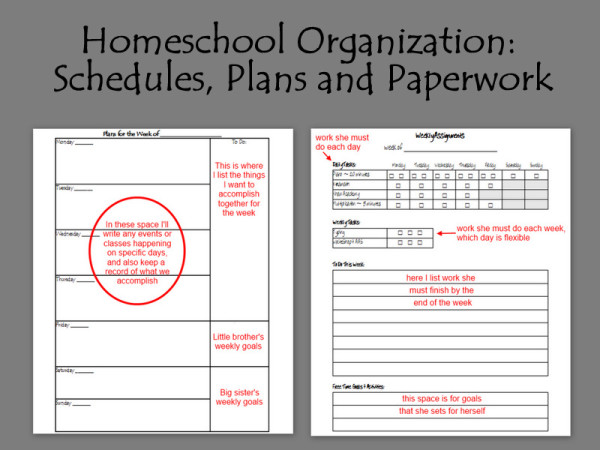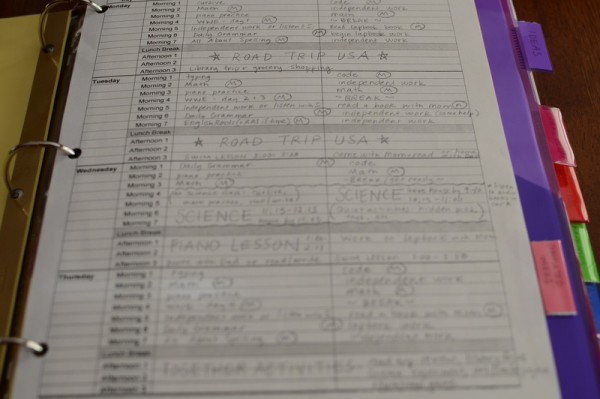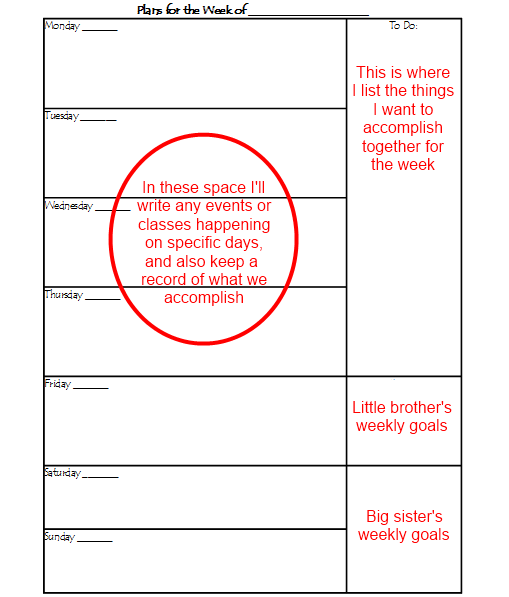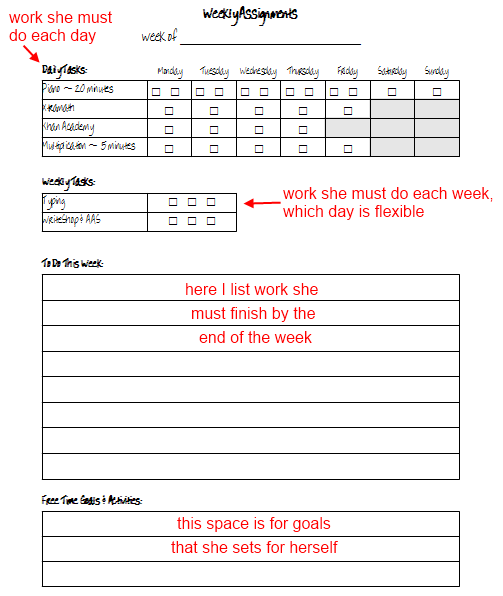Homeschool Organization: Schedules, Plans and Paperwork…Oh My!
 I’ve said it before and I’ll admit it again…I love lists! They make me feel organized and productive. Lists and schedules were one way I calmed my fears as we began homeschooling. I started with a detailed spreadsheet for each week, with time slots in fifteen minute increments, including a little “M” indicating who I would be working with in every block. I know, many of you are chuckling. Go ahead! I can laugh now, too.
I’ve said it before and I’ll admit it again…I love lists! They make me feel organized and productive. Lists and schedules were one way I calmed my fears as we began homeschooling. I started with a detailed spreadsheet for each week, with time slots in fifteen minute increments, including a little “M” indicating who I would be working with in every block. I know, many of you are chuckling. Go ahead! I can laugh now, too.

The problem was that instead of the schedule working for me, I was a slave to my schedule (dragging the kids along with me). I relaxed a little at a time until I found the level of organization that worked for me–enough to keep us on track but allow flexibility. Here’s a rundown of what I use now for planning and scheduling:
Monthly Calendars:
For our family my husband and I use Google Calendar. Yes, I fought changing to a computer-based calendar like I fight all new technology, and now I love it. We both stay up to date, and calendar alerts on my phone have saved me numerous times. Scheduled events like field trips, group meetings and classes go in Google Calendar–basically anything that requires us leaving the house.
For homeschool planning I use printable monthly calendars from Donna Young (a terrific site with loads of free resources). It’s a good place to organize my thoughts, and obviously I would clutter up Google Calendar if I added everything we do at home. Here I plan out our general school schedule: which weeks will be full time, part time or off. I write in public school schedules so we know when some of our friends are out of school. I also pencil in things like unit studies (elections/government in the fall, Christmas-related in December…) or special events we may want to celebrate or learn about.
Weekly planners:
I use two weekly planners: one for me, and one for my daughter (age 10). I made these myself in a spreadsheet program (because I already knew how to use it), and they aren’t beautiful, professional-looking forms but they are easy for me to tweak and make changes to as needed.
This is my weekly planner, and you can see I’ve relaxed quite a bit since the tiny boxes with a little “M.” I ended up with my own variation of a weekly planner from Home School Mom (scroll down to “Weekly Planner with To Do List”) with a couple changes: I plan my weeks Monday-Sunday since I usually pull things together for the week on Sunday afternoon, and I divided the “To Do” box so I would have a large area for the work we do together, and a small area for each child.

What I like best about this is the flexibility–I can still make my lists and check things off, but we can work through the weekly goals in a flexible manner. We can spend extra time reading aloud if we can’t wait to see what happens next, delve into nature study if the weather is beautiful, or break out the paint or science experiments if I don’t need to worry about the mess that day. Not only that, but it gives me permission to be flexible for the fun things (“Hey kids, Dad wants to take us out to breakfast!”) and the not-so-fun (someone just threw up) without having to scribble all over my lesson plans and schedules.
This year my daughter has her own weekly assignment sheet. Last year I began making her a handwritten list of her independent work each day so she didn’t have to ask what to do next. She enjoyed seeing what she had to do, being able to cross things off (that’s my girl!) and the independence of choosing the order of her work. For part-time summer schoolwork I made her a list for the week instead of the day and it worked even better! It saved me time (hooray!), and if something needed to carry over I didn’t have to rewrite it each day. Subjects like typing could have three check boxes, and she could decide which days to do it. I made her a printable one this year to save time and keep it neat and organized. Repeating subjects are filled in, with room to write assignments like copywork or notebooking. Note that only her individual work is there; combined subjects like science and history are not on her assignment sheet.

Do you notice the area at the bottom–free time goals and activities? I am excited about this one. My daughter has lots of hobbies (sewing, knitting, writing stories and piano songs), but still sometimes needs help finding things to do on her own when I’m not directing her activities. I made this area for her to do her own list-making, hoping it will help her focus so her free time can be productive.
So there you have it, my scheduling and planning paperwork in a nutshell. Now if only I could organize all the other papers that pile up in our schoolroom…
 Hi, I'm Heidi and I homeschool my two sweet kids. I want them to know that learning is an exciting lifelong adventure! We love great books, unit studies, notebooking, lapbooking, and hands-on learning.
Hi, I'm Heidi and I homeschool my two sweet kids. I want them to know that learning is an exciting lifelong adventure! We love great books, unit studies, notebooking, lapbooking, and hands-on learning.



